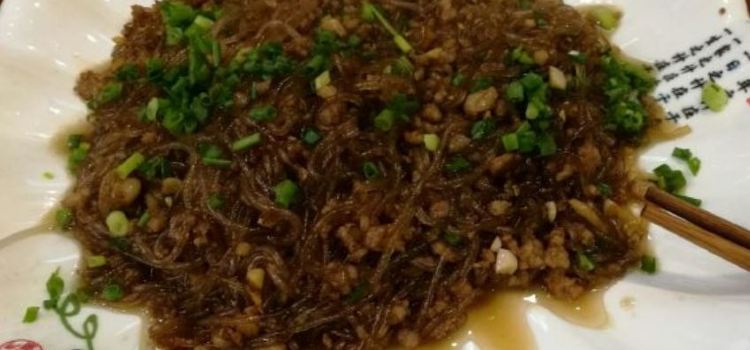DA AN SHAO NIU ROU JING PIN DIAN
5/54 Reviews
AU$10

Currently closed|Open at 11:00 today
0813-8119880
What travelers say:

It’s a good old shop. If you haven’t eaten there, you can go and try it.
More
Reviews of DA AN SHAO NIU ROU JING PIN DIAN
Some reviews may have been translated by Google Translate
5/5Outstanding
All (4)
Latest
Photo reviews (2)
Positive reviews (1)
It’s a good old shop. If you haven’t eaten there, you can go and try it.
I like roast beef the most. It's very delicious. I like it very much.
Zigong cuisine, "so fresh it makes you scream, so spicy it makes you jump," should be enjoyed this way. Salt, dinosaur fossils, and the Lantern Festival are three of Zigong's signature dishes, a rich history that has earned it its name. But for modern gourmets, the city's renowned salt cuisine is its most significant drawcard. 1\ Millennium Salt Capital / Zigong can be said to have been "born and prospered by salt," with the city's name derived from two renowned salt-producing areas: "Ziliujing" and "Gongjing." Geologists estimate that Zigong's salt deposits formed during the Triassic period, buried underground along with dinosaur fossils for over 200 million years. They were discovered during the Eastern Han Dynasty, and have been mined for over two thousand years. As one of China's oldest salt-producing areas, Zigong boasts abundant brine and simple extraction. The term "artesian" is no exaggeration: the brine lies at the surface, and a simple chisel will unleash it. Zigong also boasts a highly developed water system. The Tuojiang, Minjiang, and Fuxi Rivers meander here, converging into the Yangtze River. This allowed salt to be exported by water across Sichuan and Chongqing and sold nationwide. Such advantageous geographical conditions naturally attracted the wealthy "Salt Gang" (a group known as the "Salt Gang") to gather here, gradually developing a unique "Salt Gang" culinary culture. 2\ Salt Gang Cuisine / Sichuan cuisine is actually divided into three schools. Rong cuisine, centered in Chengdu and Leshan, is known as Upper River Gang Sichuan cuisine. It embodies the imperial court cuisine and official residence cuisine of Sichuan cuisine. Chefs strictly adhere to traditional recipes, carefully selecting high-quality ingredients and meticulously selecting and proportioning ingredients. Classic dishes include boiled cabbage and garlic-mashed pork. The Jianghu cuisine of Dazhou, Chongqing, and Wanzhou in eastern Sichuan is known as Lower River Sichuan cuisine. It favors pickled peppers and sauerkraut for seasoning, and is unrestricted by recipes, often embracing spontaneous cooking styles. Its bold use of ingredients is remarkable, and it excels at creating new twists on common ingredients. Classic dishes include sauerkraut fish and spicy chicken. The Salty Cuisine, centered in Zigong, is known as Small River Sichuan Cuisine. It excels at creating rich flavors and vibrant colors through the innovative use of seasonings. Its hallmarks are "rich, fragrant, spicy, and stimulating." Classic dishes include boiled beef, cold rabbit, and fresh pot rabbit. Within the Salty Cuisine, there are three main sub-sectors, depending on the clientele: salt merchant cuisine, salt worker cuisine, and guild hall cuisine. Salt merchant cuisine is often elaborate and extravagant, even reaching the point of being bizarre. Salt worker cuisine is heavy on oil and salt, easily eaten with rice, ensuring the workers' physical strength. Guild hall cuisine draws on culinary techniques from various regions (especially Fujian, Guangdong, and Jiangxi provinces), utilizing local specialties while also incorporating precious ingredients like abalone and shark fin, resulting in exceptional refinement. Salt Merchants' Weird Foods "Salt merchants' strange food" isn't about delicacy, but rather the cruelty of excessive extravagance. In his book "Salt," American author Mark Kurlansky describes the practice of "drowned frogs": several wooden sticks are placed over a jar of salt water. A live frog is placed inside, where it desperately clings to the sticks. The jar is then sealed. Six months later, when the frog is opened, it's already dead. After air-drying, it's successfully pickled and then steamed for consumption. Zigong salt historian Song Liangxi's research reveals even more brutal techniques for preparing "pig blood bubbles" and "roasted goose feet." Today, these appalling dishes are long forgotten, but the refined techniques and chefs' ingenuity have been preserved, remaining essential and passed down through generations in Zigong. 3. The Saltworkers' Beef Delicacies / Although Zigong boasts easily accessible salt wells like the "artesian wells," the salt merchants' thirst for salt was insatiable. At its peak, Zigong boasted over 13,000 salt wells, operating day and night. Due to the intense labor, the oxen used to pull the carts to draw brine often died within a year. Their suffering was a boon for the saltworkers. Due to the sheer number of oxen culled, the price of beef in Zigong was extremely low, so much so that many salt merchants even offered beef as collateral to the workers as wages. The saltworkers thus created numerous beef-based dishes, such as boiled beef, fire-fried beef, steamed beef with rice flour, beef with bamboo shoots, chrysanthemum beef hotpot, and cold beef. Zigong's traditional boiled beef is best prepared from the back of the cow. The technique is a one-pot dish, with the vegetables and beef cooked together before being coated in boiling oil. While the recipe may seem simple, it actually requires meticulous mastery of the heat, resulting in a product that is "numbing, spicy, fresh, fragrant, tender, and smooth," with complex and distinct flavors. To ensure consistent quality, newer methods now marinate the beef with tenderizer and stir-fry the vegetables and beef separately before drizzling with oil. This creates a significant difference in the blending of flavors. Huobianzi beef is one of the most popular salt-flavored dishes. It can be sliced and drizzled with red oil as a cold dish or enjoyed as a snack. Huobianzi is a mistranslation of "huobianzi," a torch used to illuminate the Zigong area. Salt workers used the "red, bright, and transparent" designation to praise the thin, translucent beef prepared this way, similar to the name "dengying beef." Huobianzi beef is made from the lean meat of the hind leg (commonly known as guaguarou). The meat is sliced with a sharp, thin-bladed knife until the slices are thin enough to let light through, but without any holes or cracks. The slices are lightly coated with salt, white wine, and sugar, then hung in a well-ventilated area to dry. They are then spread on a fence with ventilation and slowly smoked over a low flame using cow dung cakes until crispy but not mushy, and chewy and tender. Later, for hygiene reasons, the cow dung cakes were replaced with charcoal, but many accustomed gourmets find the unique flavor lacking. Huobianzi beef is readily available in Zigong. If you're looking for a takeaway, Yang's near the entrance of Dengganba Market is a good choice. Zigong has many famous beef restaurants, but the most popular among locals is "Da'an Roast Beef," originally located at Shenhaijing. It has now moved to Huixing Road and remains a prosperous business, but the service is somewhat average. Besides Da'an, Qiu Jin Xiao Chao on Gongcao Road is another great choice. Their classic cold beef dish features a crispy, spicy, and sizzling beef. Da'an Roasted Beef 📍 Huijingyuan, 385 Huixing Road, Basement 🕛 11:00 AM - 2:00 PM, 5:00 PM - 9:30 PM Qiu Jin Xiao Chao 📍 Room 204, 2nd Floor, Pingqiaoxi Street, Gongcao Road 🕛 11:00 AM - 1:30 PM, 5:00 PM - 1:00 AM
I heard that 📍Da'an Roast Beef was on CCTV's "A Bite of China". As a specialty food in Zigong, locals often go there. Da'an Roast Beef Boutique This store has always been very popular. I went there at dinner time and the business was really hot. It is said to be the best store in Zigong. The environment is rustic and there is a big tree in the center of the store. I saw photos of CCTV recording the program in the store. The price is affordable, the price is high, and the authentic taste is worth a try. Recommended dishes: ✅ Roast beef is a signature dish, a must-order, with three flavors of bamboo shoots, potatoes, and roka. The bamboo shoots roast beef I chose was soft and tender, the bamboo shoots were crispy, slightly spicy and fresh, and it was delicious. ✅ Oyster sauce egg tofu is a dish especially recommended for children. This tofu is very special. The egg skin is wrapped in smooth tofu, fresh on the outside and tender on the inside, so delicious that you can't stop eating it. ✅ Corn tender rabbit, fresh pepper rabbit: Zigong's rabbit is a must. The rabbit meat is tender, fresh, fragrant and peppery, and is worth a try.